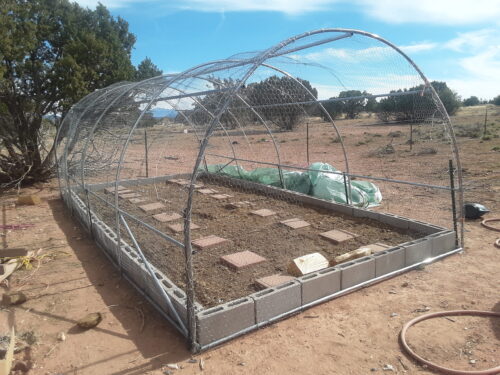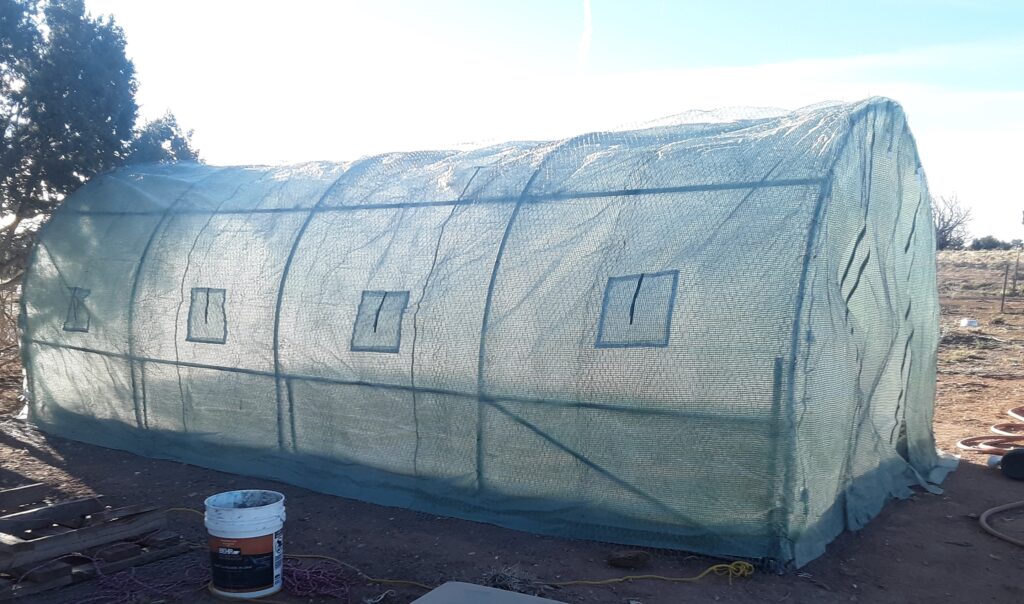
The biggest challenge to setting up a hoop house here is protecting it from the wind. In spring and fall, we regularly get wind speeds of 30-50 mph with wind gusts of 50-85 mph. K had already experienced the uprooting of a previous greenhouse, carried off during a huge wind storm, rolling the house like a tumbleweed. To prevent this from happening to the new structure, before we built it, we sited the hoop house so there was a tree to the north and another one northeast of it, to provide a bit of a wind break. Although the predominant wind direction here is southwest to northeast, storm winds often come in reverse. And placing the hoop house with a tree to the south would block too much light for growing. We then oriented the hoop house so the wind from the southwest would (hopefully) follow the contour of the hoops rather than face resistance from the front or back ends. To secure the frame, we drove in u-posts and tied the frame to them. So far, this has worked well even during windstorms with 50 mph gusts.
Securing the hoop house cover has been, and continues to be, an adventure. Unlike the greenhouse where the plastic paneling is embedded into the frame, the hoop house plastic sheeting has to be secured to the outside of the frame. This has been nearly impossible. The cover came with velcro straps that hold it onto the front and back of the hoop house, but there aren’t any to keep the cover tied down securely along the sides of the frame. To secure the cover along the sides, the hoop house came with large staples like those used to hold down weed-cloth but bigger. These garden staples did not work here because the hard and rocky soil makes them difficult to push in, and the high wind speeds whipped the cover around. We tried putting heavy things like an old car battery on the excess cover to pin it to the ground, but the cover just slipped out from under them with the wind. The hoop house also came with thin rope we used to tie the cover close to the frame which worked for a few days, but the rope snapped during a particularly strong wind gust. Next we tried holding the cover down with heavier rope and tied-together hay-bale ties, which solved half the problem by holding the cover down, but we were still unable to secure the plastic to the frame.
Our next pass was using tie-wire to tie the rip-stop cover to the frame. Rip stops are basically when the fabric is woven into a square or grid to stop rips from starting or widening as sometimes seen in clothing for pocket reinforcement. This worked really well for a few days; then a giant wind-gust tore the cover off the framing. In other words, the rip-stop failed. Luckily, the rope held the cover onto the hoop house. Our next foray was to try clips designed to keep covers on hoop houses. What a joke. As we put one on, another would pop off and launch itself a good 2-3 ft. into the distance. If the wind was down, we’d get a handful on just to have a wind-gust send them flying like popcorn. After an hour or two of chasing clips, we gave it up.

A recent windstorm started ripping the cover apart and breaking the zippers, so we took it down to keep it from bending the frame. But we haven’t given up. Our latest experiment has been to put chicken-wire over and under the cover to stop the cover from flopping around in the wind and getting torn off the frame. We have also woven the wire ties into the chicken wire and the cover as we secured it to the frame. We hope this will stop the cover from getting torn off by the wind. The chicken-wire shouldn’t obstruct too much light, either. Without the chicken-wire, not only does the cover tend to fly outward from the frame, it’s also susceptible to collapsing inward with the weight of rain or snow. A different sort of challenge. Now snow and rain can slide off rather than accumulating on the cover and collapsing onto our carefully tended onions and garlic.
Will it work? It’s holding up so far. Remember, no one said this was going to be easy; but it’s oh-so worth it!
Next blog post: Long-term water solutions
